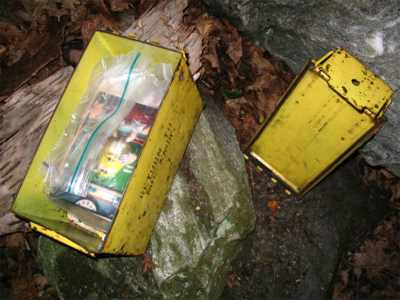GEOCACHING
Those in the UK (and other parts of the world) may be
familiar with "letterboxing"
where a box containing a rubber stamp is hidden somewhere and clues are
provided to find the stash. When you find the box, you stamp your
log book with the stamp. Sometimes there are little trinkets in the
box that you can trade. Geocaching is similar only you use a GPS
(Global Positioning System) receiver to help find the cache.
Geocaches, like letterboxes, are hidden
somewhere...anywhere...and they can contain all types of trinkets to
trade, such as marbles, little action figures, small toys, and so
on---nothing of real value, just fun things. Much of the time
geocaches are old ammunition boxes or plastic food containers.
Sometimes, though, they're a harder to find 35mm film container---or even
smaller. Sometimes the idea is to just lead you to a nice view or
something else that's interesting. And sometimes a geocache is a
clue to another geocache...or a clue to another clue where you need to
work out a puzzle. How a geocache is set up and how you get to it is
entirely up to the person who creates the geocache. And there may be
hundreds of them within a short drive of your house---in the city, in the
woods, in the wall behind the Piggly Wiggly, atop Mt. Washington, at a
rest area on a major interstate highway, hidden in a log in the
woods---you get the idea.
To find a geocache you are given GPS coordinates,
and you try to hunt down the geocache using your GPS receiver, any clues
provided, and your wits. When you find the geocache, you can fill in
a log book (usually there's one in the cache) and trade some of the
trinkets you find in the geocache if you like. If you like, you can
visit the main geocaching web site,
create a free account, and log your finds there, too.
The GPS receiver I use is the
GARMIN 60CSx.
It has a special mode for geocaching. You don't need such a fancy
GPS unit, though, as long as your GPS receiver tells you where you are and
allows you to enter the latitude and longitude coordinates of a
destination so you can see where you're going!
The geocache I went looking for in the Notch is
called
"'Smugglers Notch' Reborn". Eventually I found it, but I'm
not going to tell you where---that would spoil the fun! It was a bit
of a challenge because the Notch has a lot of tree cover, and that
sometimes fools GPS receivers. The cache turned out to be a yellow
ammo box with a variety of trinkets.

In that cache were supposed to be
"travel bugs" and "geocoins". These are little objects that have a
goal in mind, such as traveling around the world, visiting Florida, or
visiting as many geocaches as possible in Vermont. You can take
these objects and move them to other caches that help the objects reach
their goal. Unfortunately it looks like someone got there before I
did and removed the items, so I didn't get to move anything around to the
other caches that I visited over the weekend.
Geocaching is a fun game, and it can be challenging
at times. Some caches are easy to find and obvious, others can be
hidden well or buried in a puzzle. One series of caches follows the
old Middlesex Canal in Massachusetts, USA, and the only way to find the
final cache is to work out the puzzle to find the first one, and using
clues in the cache you find the second one, and so on. There's about
a dozen like that in the series. Oy! But many are just boxes
tucked away somewhere and are relatively easy to find when your GPS leads
you to the area.
Geocaching is fun for all ages. Kids love the
"treasure hunting" aspect. All you need is a GPS and a bit of
cleverness, and you're there. Visit
geocaching.com for more info.
After my big find at the top of the Notch it was time to find
another further along 108...but I turned up nothing. A geocache I tried to
find later in the weekend left me hanging as well! I went back to that one
along 108 on my way home, and---this time---got it within a few minutes.
Sometimes it's like that. It's all fun, though.
